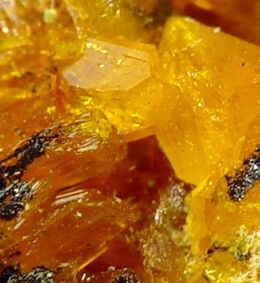Chemistry:Billietite
From HandWiki
| Billietite | |
|---|---|
 Becquerelite (yellow) and billietite (orange) | |
| General | |
| Category | Oxide minerals |
| Formula (repeating unit) | Ba(UO2)6O4(OH)6•8H2O |
| Strunz classification | 4.GB.10 |
| Dana classification | 5.7.1.3 |
| Crystal system | Orthorhombic |
| Crystal class | Pyramidal (mm2) (same H-M symbol) |
| Space group | Pbn21 |
| Identification | |
| Color | Yellow to golden-yellow, amber-yellow, orange-yellow |
| Cleavage | Perfect on {001}, imperfect on {110} and {010} |
| Tenacity | Brittle |
| |re|er}} | Adamantine |
| Diaphaneity | Transparent, translucent |
| Density | 5.28 - 5.36 g/cm3 |
| Other characteristics | |
| References | [1][2] |
Billietite is an uncommon mineral of uranium that contains barium. It has the chemical formula: Ba(UO2)6O4(OH)6•8H2O. It usually occurs as clear yellow orthorhombic crystals.[4] Billietite is named after Valere Louis Billiet (1903–1945), Belgian crystallographer at the University of Ghent, Ghent, Belgium.
Billietite was discovered in the locality of the Shinkolobwe uranium mine in the Haut-Katanga Province of the Democratic Republic of the Congo (DRC).[2]
References
- ↑ Mineralienatlas
- ↑ 2.0 2.1 Mindat.org - Billietite
- ↑ Warr, L.N. (2021). "IMA–CNMNC approved mineral symbols". Mineralogical Magazine 85 (3): 291–320. doi:10.1180/mgm.2021.43. Bibcode: 2021MinM...85..291W.
- ↑ M. Katherine Pagoaga, Daniel E, Appleman, & James M. Stewart "Crystal structures and crystal chemistry of the uranyl oxide hydrates becquerelite, billietite, and protasite" American Mineralogist, Volume 72, pages 1230-1238, 1987 [1]
External links
 |

